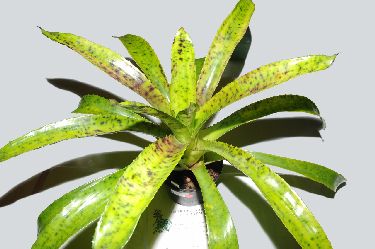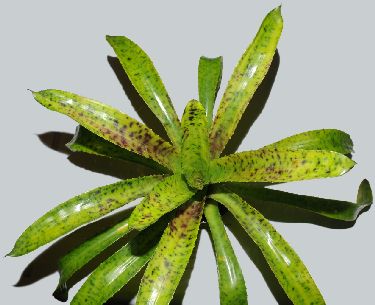

Copied from fcbs site...
"Uncle Derek Says"
WITTROCKIA 'LEOPARDINUM'
"It is strange that a plant introduced in 1888 and rarely flowers should persist in collections in Europe, the USA, and Australasia. I had grown this plant as Canistrum leopardinum for 15 years and gave up in disgust because it did not like Adelaide winters AND did not even try to flower! However, as the photograph by Gerry Stansfield shows, this is a handsome plant when in flower.
The first mention of this plant is in Revue Horticole (1888) where on page 201 Jacob Makoy and Company introduce a Canistrum leopardinum. No further information is given. In "Les Bromeliacees" by Duval (1896) (reprinted as "The Bromeliads" in 1990 by Rothenberg and Read) Canistrum leopardinum Hort is mentioned but no further information.
In "Das Pflanzenreich", Bromeliaceae by Mez 1934 there is no mention of C. leopardinum.
In 1942 in "Catalogue des Bromeliacees" by Chevalier and Son C. leopardinum Hort. Leod. is mentioned as non-classified but still a species.
In 1946 in "The Bromeliads" by Dutrie (Translated and reprinted in JBS 1988 p20) the following information is given.
"C. xLeopardinum Hort. Makoy. A very beautiful species, the sturdiest of the genus. Leaves numerous, thick, leathery, in a short rosette, strongly sheathed, 70- 80cm long, 7 - 8cm wide, erect, spreading, edged with strong, black spines, and brilliantly green flecked with irregular dark green or brownish spots. Rarely blooms. M. Declercq van Ghyseghem managed to obtain seeds about 1935."
Here the name is prefaced with an "x" to denote hybrid but the word species is used in the text. Could it have been in the mind of the translator that this was a hybrid because elsewhere in the translation there is clear, unarguable use of the hybrid indicator!
In "Bromeliads " by Padilla ( 1973) we find the first reference to this being a hybrid where alleged parents are given. I quote "Canistrum Ingratum (Now Wittrockia gigantea) x Roseum (Now Edmundoa lindenii var. rosea).- a large handsome foliage plant with mottled green leaves that turn purplish red if the plant is grown in good light. The inner rosette is dark wine-red; the petals are purple"
No indication was given as to the source of the parentage although the description seems correct except for the purple petals !
This parentage was repeated with a few typographical errors in the International Checklist of Bromeliad Hybrids (1979) and updated in the Bromeliad Cultivar Registry 1998 but with the same colouration repeated as in Padilla (1973)
No reference to Canistrum leopardinum is made in Smith & Downs Bromelioideae (1979)
In "Canistrum" (1997) Leme treated C. leopardinum as a species and considered it to be synonymous with his Wittrockia gigantea. He mentioned he had seen C. leopardinum in Australia and I knew he had been to the Australian Bromeliad Conference in Brisbane in 1993. On reading this book I telephoned a friend in Brisbane and asked about C. leopardinum. It transpired that there were two 'leopardinums' in Brisbane - one with concolorous leaves and one with spotted leaves. Did Leme see one or both forms? Was Leme incorrect? Was C. leopardinum a hybrid?
I started asking questions. In 1999 Brian Chan from California reported white flowers but was not prepared to dissect someone else's plant!
Things really started moving in 2001 (ONLY 113 years after it was named!) when Gerry Stansfield of New Zealand sent me a photograph of 'Leopardinum ' in flower. He had used 'ethylene' pills recommended by Herb Plever of New York! Gerry was prepared to 'butcher' his plant for science and found the inner workings of a Nidularioid inflorescence a new experience. He found things he had never seen before. I had the same experience and certainly Elton Leme has shown he found things not previously reported! There is NO hair to be found in the inflorescence negating the claim by Padilla that Edmundoa lindenii (was Canistrum) was involved in its make-up.
The differences we found from Leme's description of W. gigantea were.
Petals only 30mm long not 45mm
Sepals rusty-red not yellow.
Primary bracts broader and red, tipped green and blotched, not yellow-green and red towards apex and not blotched,
Leaves 90mm wide not 40- 60mm
Leaves gradually narrow from sheath to blade not a narrowing between sheath and blade.
Leaves strongly marked with blotches and spots not concolorous.
The sepal colour is interesting because, post floral, it seems to have been confused with petal colour. The description of C. giganteum in Smith & Downs (1979) shows petals yellow but as Leme pointed out the petals are really white. In our 'Leopardinum' the sepals are rusty-red and could well be what was quoted as petal colour in Padilla (1973).
In the description for W. gigantea Leme does not mention any spotting of the leaves (as he does with Nidularium rutilans) but this information has been published for C. leopardinum. This supports my view that he did not see the spotty leaved non-flowering plant in Queensland.
I believe that C. leopardinum is very close to Wittrockia gigantea and intend to treat this cultivar as a form of W. gigantea and not a hybrid.
Gerry Stansfield has suggested that the plant seemed bigeneric in origin but we have checked all the traits of the Nidularioid complex and cannot suggest what the other parent may be. Clearly this plant has not been found again in the wild which we can only assume is in the vicinity of Rio de Janeiro. Despite the fragmentation of the Brazilian forests, particularly the Atlantic Forest, old, almost forgotten, species are still being found and perhaps Elton Leme, Tanya Wendt, Andrea Costa, or others may find our 'Leopardinum' and correctly describe it.
In the meantime the Bromeliad Cultivar Registry will be amended to read Wittrockia 'Leopardinum' cv. of W. gigantea."
Derek Butcher
Adelaide
References
Beadle, D. 1998 Bromeliad Cultivar Registry
Chevalier & Son 1942 Catalogue des Bromeliacees
Dutrie, L. 1946-8 Bulletin Horticole
_. 1988. JBS 38 p20
Duval, L. 1896. Les Bromeliacees
__. 1990. The Bromeliads
Leme, E M C 1997, Canistrum - Bromelias da Mata Atlantica/Bromeliads of the Atlantic Forest. Salamandra, Rio de Janeiro. pp 70-72
Makoy, 1888 Revue Hort 60:201
Mez, C. 1934 Bromeliaceae in Engler Pflanzenr. IV
Padilla, V , 1973 Bromeliads_ .
1979. International Checklist of Bromeliad Hybrids Smith, L B & Downs, R J 1979.Bromelioideae (Bromeliaceae), Fl. Neotrop. Monogr. 14 The New York Botanical Gardens, New York p1719